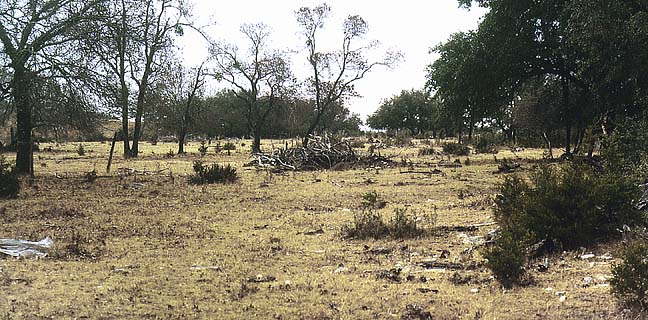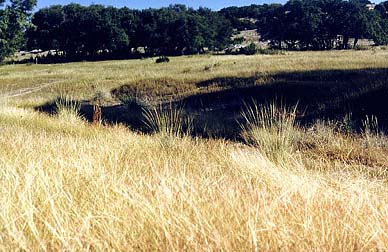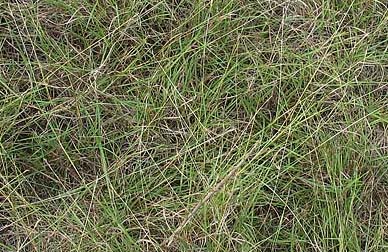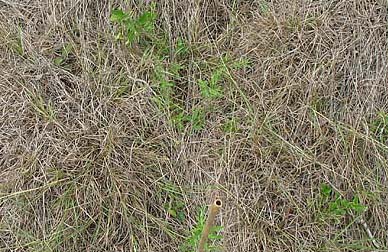Thirty years of King Ranch Bluestem (Bothriochloa ischaemum var. songarica) in N. Hays County
by Bob Harms


Heavily grazed KR bottomland, winter 1977
Since 1977 the state of King Ranch Bluestem (KR) on our 50 acre ranchland in N. Hays County has constantly changed, from badly overgrazed when we first got it, to aggressive invader in the early years after cessation of grazing, and eventually to decrepit old bunches in recent years. One late July burn caused by dry lightning in 1988 led to a revitalization, that is only now showing signs of age. After its initial surge into dominance it has gradually yielded to native grasses in all but a few areas, primarily bottomland with deep calcareous black clay, and even there it is gradually giving way to natives.

Emerging KR fields in late 1977
|

July 2007 detail of area of 1988 burn
|

July 2007 detail of area not touched for 30 years
[Green forbs are wild petunia (Ruellia nudiflora) and plateau silverbush (Argythamnia simulans)]
|
Our 3 decades of experience support the statement in Correll & Johnston 1970 (p. 198):
Widespread along roadsides, where sown by highway department, spring-fall; introd. from the steppes of n. Asia; reportedly a promising pasture grass in s. Tex. but not persisting except in cult. or along roadsides.
Of course, "not persisting" must be taken to mean "over the long run." I suspect that one reason for a recent rash of efforts devoted to KR removal is that as hill country pastureland in the areas close to cities has become gentrified and is no longer grazed, KR currently appears to be a dominant invader, yielding only to the even worse invasion of Ashe junipers or Johnsongrass. No one has the patience to let nature run its course, and I can appreciate the desire for quick remedies by newly arrived land holders. On the other hand, the sky is not falling, and I am unaware of any scientific studies that demonstrate cause for long term ecological concern.
Our experience indicates:
- Little bluestem (Schizachyrium scoparium) has never yielded to KR, and is slowly becoming the dominant grass of open areas, especially on slopes. Also not yielding, but no match for little bluestem, are:
- rough dropseed (Sporobolus clandestinus)
- Texas wintergrass (Nassella leucotricha)
- silver bluestem (Bothriochloa saccharoides var. torreyana)
- plains lovegrass (Eragrostis intermedia)
- KR has never outcompeted rhizomatous grasses, e.g.,
- sideoats grama (Bouteloua curtipendula)
- Indiangrass (Sorghastrum nutans),
- Johnsongrass (Sorghum halepense)[our most troublesome invasive exotic]
- Reverchon bristlegrass (Setaria reverchonii)
-
In shallow arid soils KR has yielded to (often shorter) native grasses; i.e.
- Hall's panicgrass (Panicum hallii)
- Texas grama (Bouteloua rigidiseta)
- curlymesquite (Hilaria belangeri)
- fall witchgrass (Digitaria cognata)
- hairy grama (Bouteloua hirsuta)
- hairy tridens Erioneuron pilosum
- purple threeawn (Aristida purpurea)
- red grama (Bouteloua trifida)
- slim tridens (Tridens muticus)
- tall grama (Bouteloua pectinata)
-
KR is not generally found with grasses of moist (even if only seasonally), strongly shaded areas or in juniper mulch; i.e.
- bushy bluestem (Andropogon glomeratus)
- cedar rosettegrass (Dichanthelium pedicellatum)
- dallisgrass (Paspalum dilatatum)[easily controlled invasive exotic]
- hairy brome (Bromus pubescens)
- hairy dropseed (Sporobolus compositus var. drummondii)
- Indian woodoats (Chasmanthium latifolium)
- purpletop (Tridens flavus)
- scribner's panicum (Dichanthelium oligosanthes var. scribnerianum)
- switchgrass (Panicum virgatum)
- vaseygrass (Paspalum urvillei)[troublesome invasive exotic]
- water bentgrass (Polypogon viridis)
- white tridens (Tridens albescens)
- woolly rosettegrass (Dichanthelium acuminatum)
-
On flats in very shallow soil the annual poverty dropseed (Sporobolus vaginiflorus) has trumped all others.
- Our native Muhlenbergias — i.e.,
- Lindheimer's muhly (M. lindheimeri),
- canyon muhly (M. involuta),
- seep muhly (M. reverchonii),
- aparejograss (M. utilis)
— have never yielded to KR, although all but Lindheimer's muhly are in terrain, either arid and rocky or wet, avoided by KR.
-
Buffalo grass (Buchloe dactyloides) is the only grass that seems to have mostly disappeared over the past 3 decades, but it persisted the longest in mown KR dominated areas.
-
Grasses with no apparent interaction with KR on our land:
- sandbur (Cenchrus incertus)[not seen recently]
- windmill grass (Chloris verticillata)[not seen recently]
- bermudagrass (Cynodon dactylon)[uncommon]
- Ozark grass (Limnodea arkansana)[annual, common in some years]
- hairyseed paspalum (Paspalum pubiflorum)[not common]
- southwestern bristlegrass (Setaria scheelei)[not common]
In sum, our 30 year experience with KR in N. Hays Co. indicates that with time the Correll & Johnston prognosis will prove correct.

